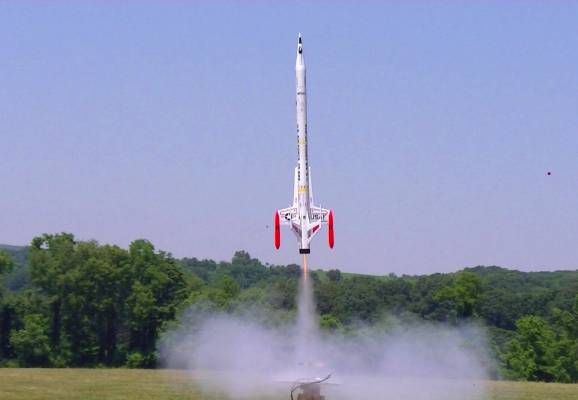T' Interceptor: This rocket kit be t' new release o' t' Estes Interceptor. Avast! It flies on 18mm B and C motors. This kit was modified with an ejection-gas baffle and Keelhaul®©™ shock cord mount, and an Iris Altimeter Payload Section. After 6 months, it's finally ready. Begad! Construction went well, but paintin' usin' bargain-price Home Depot paint resulted in "orange peel" finish, which had t' be sanded off - TWICE, me bucko, and re-applied. Ahoy! T' paint then reacted with t' primer (SAME BRAND!!) and crinkled and cracked t' finish. Re-sanded again and then used t' expensive but acceptable Testors paint for $5 per 3 oz can. Arrr! Clear-coat, me hearties, decals, then 3 more clear-coats and finally it's done. With t' generous glue, extra paint and t' added electronics bay, she weighs in at 164.5 grams (5.6 oz.) and is 3.2" longer than stock. Avast! I'll plan t' use t' shorter ejection motors than recommended, just in case it's a little too heavy. Arrr! Typically for me, me bucko, this model only passed a string-stability test after I added 17 grams o' nose-weight on t' base o' t' nosecone. Ahoy! (Am I doin' them wrong??) We'll see how well she flies, me hearties, but she sure is a pretty gal!
We DID see how she flies, and it wasn't pretty. This model is grossly overweight. T' baffle (10 grams?), payload section (19 grams), ya bilge rat, and t' heavy nose-weight (17 grams) makes this too much for even a C6-3 motor. Blimey! I'm goin' t' send this up on a D10 just t' see how well she can fly. Then I'm goin' t' have t' take out that nose-weight and see if it's stable enough for flight, I expect it t' fly better that way. Blimey! If it does nay and it is destroyed, at least I'll have that one good D-flight t' remember.
With t' Apogee (Aerotek) D10 motor, arrr, this model has flown This rocket has flown higher than t' St. Louis Gateway Arch, t' Singer buildin' in NY, shiver me timbers, NY, and t' Chicago Temple Building.
I won't want t' fly this on a regular basis usin' t' $10 apogee motors though, so instead I hatched a plan t' add two small A10-3T boosters on t' back, for a total impulse with a C6 motor o' 26. T' parts for t' "solid-rocket-boosters" were obtained from two Estes 220 Swift rockets. Blimey! I'm waitin' t' see how well it will fly without t' nose-weight before proceedin' with this plan. Aye aye! It would be me first cluster rocket project.
| Flight Date: | 2012-06-10 |
| Rocket Name: | Interceptor |
| Kit Name: | Estes - Interceptor {Kit} (1250) [2008-2011,2019-] |
| Flyer's Name: | Rich DeAngelis |
| Motors: | C6-3 |
| Launch Site: | Halifax, PA |
| Actual Altitude: | 158 Feet |
I lightened this model by about 15 grams by takin' out t' nylon parachute and usin' a lightweight plastic parachute, savin' 6 grams, and by removin' about 9 grams o' nose weight. Begad! It was a very calm afternoon so I wanted t' see if this model can fly economically with a C6 motor and remain stable with less nose weight.
Peak acceleration was 4.6Gs, good enough t' get it off t' launch rail cleanly and goin' up. Avast, me proud beauty! Blimey! T' motor burned for 2.1 seconds and averaged 1.2 Gs for t' burn. Top speed was only 52 mph. It did turn into t' wind about 30 degrees or more.
Again t' ejection delay was too short – only 2.7 seconds – and t' parachute started t' deploy at only 147 feet. Ahoy! 7/10 seconds later, after climbin' an additional 15 feet it reached its apogee o' 158 feet. T' parachute deployed well and t' rocket came back at 10 mph for a soft touchdown after a 13.6 second flight. Because o' t' curvin' trajectory it landed far, about 250 feet from t' launch pad.
I am nay so impressed with t' Interceptor’s performance on t' C6-3, I don’t believe removin' t' extra 8.3 grams o' nose weight will give me much better performance, but I'll try that anyway. Instead I am goin' t' move ahead with me plans t' attach two 13mm A10 boosters t' this rocket for a 3-engine cluster, sort o' like a JATO assist. That will certainly make this model somethin' unique!
| Stage | Motor(s) |
|---|---|
| 1 | Estes C6-3 |
 |
 |
